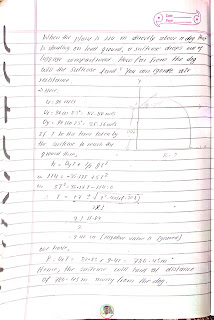Syllabus:
- 1.1 Demonstrate the meaning, importance and applications of precision in the measurements 1.2 Understand the meaning and importance of significant figures in measurements 1.3 Explain the meaning of dimensions of a physical quantity 1.4 Workout the dimensions of derived physical quantities applicable to this syllabus 1.5 Apply dimensional analysis method to check the homogeneity of physical equations
- 2.1 Distinguish between scalar and vector quantities 2.2 Add or subtract coplanar vectors by drawing scale diagram (vector triangle, parallelogram or polygon method) 2.3 Understand the meaning and importance of unit vectors 2.4 Represent a vector as two perpendicular components 2.5 Resolve co-planer vectors using component method Describe scalar and vector products 2.7 Understand the meaning and applications of scalar and vector product with examples 2.8 Solve related problems.
- 3.1 Define displacement, instantaneous velocity and acceleration with relevant examples 3.2 Explain and use the concept of relative velocity 3.3 Draw displacement-time and velocity-time graph to represent motion, and determine velocity from the gradient of displacement-time graph, acceleration from the gradient of velocity-time graph and displacement from the area under a velocity-time graph 3.4 Establish equations for a uniformly accelerated motion in a straight line from graphical representation of such motion and use them to solve related numerical problems 3.5 Write the equations of motion under the action of gravity and solve numerical problem related to it 3.6 Understand projectile motion as motion due to a uniform velocity in one direction and a uniform acceleration in a perpendicular direction, derive the equations for various physical quantities (maximum height, time of flight, time taken to reach maximum height, horizontal range, resultant velocity) and use them to solve mathematical problems related to projectile motion
- 4.1 Define linear momentum, impulse, and establish the relation between them 4.2 Define and use force as rate of change of momentum 4.3 State and prove the principle of conservation of linear momentum using Newton’s second and Newton’s third of motion 4.4 Define and apply moment of a force and torque of a couple 4.5 State and apply the principle of moments 4.6 State and apply the conditions necessary for a particle to be in equilibrium 4.7 State and explain the laws of solid friction 4.8 Show the coefficient of friction is equal to the tangent of angle of repose and use the concept to solve problems. 4.9 Solve the numerical problem and conceptual question on dynamics
- 5.1 Explain work done by a constant force and a variable force 5.2 State and prove work-energy theorem 5.3 Distinguish between kinetic energy and potential energy and establish their formulae 5.4 State and prove the principle of conservation of energy 5.5 Differentiate between conservative and non-conservative force 5.6 Differentiate between elastic and inelastic collision and hence explain the elastic collision in one dimension 5.7 Solve the numerical problems and conceptual questions regarding work, energy, power and collision
- 6.1 Define angular displacement, angular velocity and angular acceleration 6.2 Establish the relation between angular and linear velocity & acceleration 6.3 Define centripetal force 6.4 Derive the expression for centripetal acceleration and use it to solve problems related to centripetal force 6.5 Describe the motion in vertical circle, motion of vehicles on banked surface 6.6 Derive the period for conical pendulum 6.7 Solve the numerical problem and conceptual question on circular motion
- 7.1 Explain Newton’s law of gravitation 7.2 Define gravitational field strength 7.3 Define and derive formula of gravitational potential and gravitational potential energy 7.4 Describe the variation in value of ‘g’ due to altitude and depth 7.5 Define center of mass and center of gravity 7.6 Derive the formula for orbital velocity and time period of satellite 7.7 Define escape velocity and derive the expression of escape velocity 7.8 Find the potential and kinetic energy of the satellite 7.9 Define geostationary satellite and state the necessary conditions for it 7.10 Describe briefly the working principle of Global Position -System (GPS) 7.11 Solve the numerical problems and conceptual questions regarding related to the gravitation
- 8.1 State and explain Hooke’s law 8.2 Define the terms stress, strain, elasticity and plasticity 8.3 Define the types of elastic modulus such as young modulus, bulk modulus and shear modulus 8.4 Define Poisson’s ratio 8.5 Derive the expression for energy stored in a stretched wire 8.6 Solve the numerical problems and conceptual questions regarding elasticity



































































































































